With their piercing eagle eyes and strong sharp talons, these glorious raptors are known for their powerful flight tactics and precise hunting and fishing skills. The Bald Eagle (Haliaeetus leucocephalus) is considered to be an apex predator and one of the largest birds of prey in North America (Elliott et al. 2015).
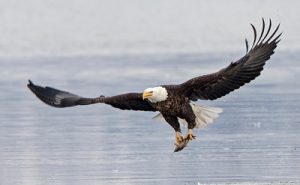
A Bald Eagle catching its prey (Photo by Rob Palmer)
As mentioned in my previous blog post, eagles feed primarily on fish but are quite adaptable, including other birds, reptiles and small mammals into their diet (The Cornell Lab of Ornithology, 2015). In some cases, these efficient predators can actually deplete small prey populations (Harvey et al. 2012).
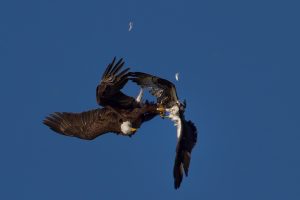
A Bald Eagle stealing food from an Osprey, demonstrating kleptoparasitism (Photo by Martin Belan)
These birds of prey are natural born hunters that have adopted various opportunistic feeding strategies to meet their high daily dietary requirements associated with their large size and costly flight (Harvey et al. 2012). An interesting adaptation to acquiring their food is known as kleptoparasitism (stealing the food of other animals) (Dekker and Drever, 2015), allowing them to reap the rewards of others, with little effort!
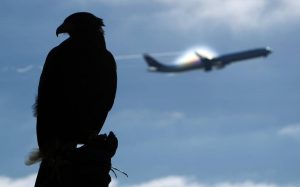
A raptor keeping an eye out on the runway at YVR (Photo by Ben Nelms of The Globe and Mail)
FUN FACT: Some organizations such as The Raptors use Bald Eagles and other birds of prey as a form of wildlife management in locations such as the Vancouver International Airport. Since raptors are natural predators, they can effectively control various problem species including gulls, crows and robins by chasing them out of the area, clearing runways and preventing potential aircraft collisions (The Raptors, 2016).
Check out the link below that includes a short video and the CBC news story about Hercules, the juvenile Bald Eagle who has joined the team of raptors working to keep the Vancouver International Airport runways safe and free of problem bird species!
To learn more about wildlife management apart of The Raptors Organization click here: http://pnwraptors.com/wildlife-management/
As discussed in my previous blog post, the Bald Eagles were apart of a miraculous conservation success story, overcoming severe population declines due to pesticides such as DDT (Sorenson et al. 2017) and other anthropogenic (human-caused) effects including habitat destruction (The Cornell Lab of Ornithology, 2015). However, the growing populations of Bald Eagles has presented some challenges for natural resource management (Harvey et al. 2012), and has lead to a shortage of food resources for these marvelous birds.
In the winter months, the fish in local streams become less abundant and resident (non-migratory) Bald Eagles undergo dietary shifts, feeding instead on small water birds and land mammals (Turrin et al. 2015). Some individuals however, take these dietary adjustments to a new and unfortunate level, seeking resources from nearby landfills.
Dozens of bald eagles take advantage of a deer carcass while foraging at the Landfill in Kitimat, bc (Video by 2sadcasp)
Landfills provide constant and abundant alternative food sources to many birds including Bald Eagles (Elliott et al. 2006). On one hand, landfills have actually proven to increase the reproductive success and number of nesting colonies in regions that have otherwise been unable to sustain such bird populations (Elliott et al. 2006). However, landfills, as you can expect have also been shown to decrease avian survival and reproduction due to poor food quality and the increased transmission of disease (Elliott et al. 2006), along with a greater chance of experiencing food piracy (Turrin et al. 2015).
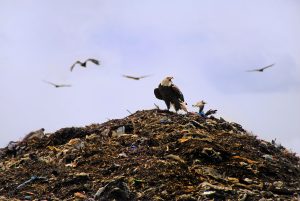
A Bald Eagle garding his garbage (Photo by Andrea Westmoreland)
One Vancouver based study found that 95% of the material consumed by Bald Eagles at landfills included household food refuse, especially red meat waste and bones (Elliott et al. 2006). Sadly, these birds are also consuming paper towels, plastic bags and other unsafe elements of household and industrial garbage. Overall, Bald Eagles were found to obtain approximately 10% of their daily energy requirement from landfills (Elliott et al. 2006). The same study found 60% of the food items obtained in the landfill were pirated by birds and that 84% of these kleptoparasitic attacks were directed at other eagles, with the number of attacks increasing with the number for foraging eagles (Elliott et al. 2006).
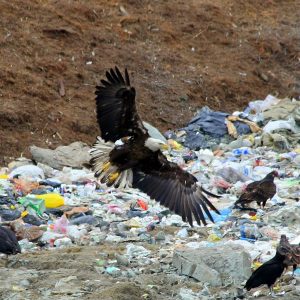
A Bald Eagle soaring over a pile of trash at the landfill, perhaps he just finished having lunch? (Photo by Gail Baker)
A second study in the Chesapeake Bay area was able to conclude that juvenile and subadult (under the age of 5) Bald Eagles are more likely to forage in landfills than their adult counterparts (Turrin et al. 2015) due to their lack of hunting experience. These young birds favor the easily accessible, low quality food items available at landfills. Researchers noticed non breeding Bald Eagles visited the landfills less frequently (Turrin et al. 2015), relying on their expert hunting skills and foraging strategies in times when natural food sources become less abundant.
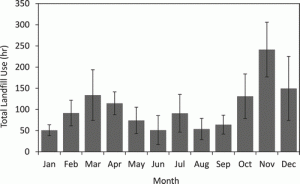
Landfills become a more desirable food source as the months move into winter with local food sources becoming limited. (Graph from Turrin et. al. 2015)
Both studies found that Bald Eagle attendance at landfills tends to increase slightly over the winter months, corresponding to seasonal food shortages (Elliott et al. 2006; Turrin et al. 2015).
Below are two links to some interesting local news coverage involving Bald Eagles foraging at landfills:
http://vancouver.24hrs.ca/2016/01/04/eagles-dying-from-dining-at-vancouver-landfill
http://www.cbc.ca/news/canada/thunder-bay/biologist-fears-for-bald-eagles-gorging-at-dump-1.1013867
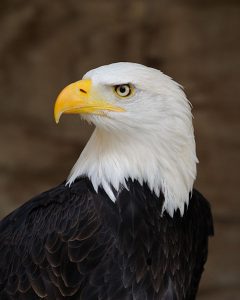
The Bald Eagle (Photo by Unknown)
The Bald Eagle highlights a remarkable comeback story, as these beautiful birds continue to thrive in our local areas. However, with their increasing population size comes a shortage of vital resources such as food, and the landfill appears to be the next best option for many Bald Eagles. Although this abundant source may deliver short term profits to these birds, it is also a massive cause of illness and disease due to the consumption of indigestible material or low quality food.
Fortunately, the number of eagles seeking resources from landfills remains relatively small, and as was previously mentioned, Bald Eagles are thriving like never before, enabling us to admiring these stunning and resilient creatures for many years to come!
References:
Dekker, D. and M.C. Drever. 2015. Kleptoparasitism by Bald Eagles (Haliaeetus leuconcephalus) as a Factor in Reducing Peregrine Falcon (Falco peregrinus) Predation on Dunlin (Calidris alpine) Wintering in British Columbia. The Canadian Field-Naturalist 129: 159-164. Retrieved November 12, 2017 from https://www.sfu.ca/biology/wildberg/NewCWEPage/papers/DekkerDreverCFN2015.pdf
Elliott, J.E., Brogan, J., Lee, S.L., Drouillard, K.G. and K.H. Elliott. 2015. PBDEs and Other POPs in Urban Birds of Prey Partly Explained by Trophic Level and Carbon Source. The Science of The Total Enviornment 524-525: 157-165. Retrieved November 13, 2017 from https://www-sciencedirect-com.ezproxy.viu.ca/science/article/pii/S0048969715004441
Elliott, K.H., Duffe, J., Lee, S.L., Mineau, P. and J.E. Elliott. 2006. Foraging Ecology of Bald Eagles at an Urban Landfill. The Wilson Journal of Ornithology 18(3): 380-390. Retrieved November 12, 2017 from http://www.bioone.org.ezproxy.viu.ca/doi/pdf/10.1676/04-126
Harvey, C.J., Moriarty, P.E. and E.P. Salathé Jr. 2012. Modeling Climate Change Impacts on Overwintering Bald Eagles. Ecology and Evolution 2(3): 501-514. Retrieved November 13, 2017 from http://onlinelibrary.wiley.com/doi/10.1002/ece3.204/full
Sorenson, K.J., Burnett, L.J. and M.M. Stake. 2017. Restoring a Bald Eagle Breeding Population in Central California and Monitoring 25 Years of Regional Population Growth. Journal of Raptor Research 52(2): 145-152. Retrieved November 12, 2017 from http://www.bioone.org.ezproxy.viu.ca/doi/pdf/10.3356/JRR-16-35.1
The Cornell Lab of Ornithology. 2015. All About Birds: Bald Eagle. [Internet]. Retrieved November 10, 2017 from https://www.allaboutbirds.org/guide/bald_eagle/id
The Raptors. 2016. Wildlife Management [Internet]. Retrieved November 13, 2017 from http://pnwraptors.com/wildlife-management/
Turrin, C., Watts, B.D. and E. K. Mojica. 2015. Landfill Use by Bald Eagles in the Chesapeake Bay Region. Journal of Raptor Research 49(3): 239-249. Retrieved November 12, 2017 from http://www.bioone.org.ezproxy.viu.ca/doi/pdf/10.3356/JRR-14-50.1
Another great blog post Chanelle! I am curious to see what future research will be done on the Bald Eagles foraging in landfills. If it is mostly young, inexperienced Bald Eagles found in landfills I wonder if in future years they will continue to feed in landfills as adults and what types of impacts these effects will have on their survival and reproduction. This is definitely an interesting topic for future study!
Thanks for your interest Nicole! Currently, there appears to be a limited amount of research concerning Bald Eagle foraging at the landfill, however, I was able to find a little bit of information to hopefully answer your question! Hatch year Bald Eagles are known to spend the most time foraging in landfills compared to any other age class, suggesting landfill use decreases with age. Many juvenile Bald Eagles have been spotted foraging at multiple different landfill sites, suggesting their heavy reliance on landfills as their main food source (Turrin et al. 2015). Eagles who frequent landfills are at an increased risk of early death due to low-quality food, disease, toxicity and injury associated with foraging in landfills (Turrin et al. 2015), suggesting an extensive and negative impact on both their survival and reproduction. Unfortunately, I was unable to find any information regarding a juvenile’s likelihood of continuing to forage in landfills in adulthood. However, I would find this likely, as these birds wouldn’t have the hunting and fishing experience necessary to exploit high quality food resources. Future research in this area would definitely prove beneficial!
Very nice! We assume that feeding at landfill likely leads to disease, toxicity and possible injury. Have you seen any studies that looked at that? One wonders the long-term population effects.
Thanks again Eric! There are definitely many negative impacts to bird health caused by foraging at the landfill. In the research I conducted for my blog, I was unable to find any articles specific to the study of disease or toxicity experienced by Bald Eagles with respect to landfill foraging. However, one article based on a study at the Vancouver landfill, provided a good overview of the literature in their introduction (http://cescos.fau.edu/gawliklab/papers/ElliotKHetal2006.pdf). Here, they explain that landfills generally decrease avian survivorship for multiple reasons including those you’ve listed above. Other sources cited within Elliott et al. 2006 have stated that landfills have proven to actually support eagle populations, providing them with an abundant food source allowing for an increase in their carrying capacity and therefore their populations! I suppose this is really a case of whether or not the benefits actually outweigh the costs. In my opinion, over the long term, landfills do more harm than good, for the case of almost every animal. I suspect that the eagle populations would show decline if heavy foraging in landfills continued or even became more popular among these raptors. Not only are landfills threatening their health, but this abundant yet toxic food source can also interfere with their hunting strategies, again having significant impacts to the population.
Nice. I like how your reply could be another blog :). I know Kyle (Elliott) from some time I spent at the Long Point Bird Observatory. He’s now a prof at McGill University doing really cool research. You can also meet Kyle in this huge Youtube video hit (14+ million views!) when he was getting botflies removed from his back after a trip to Panama (https://youtu.be/23eimVLAQ2c). Hope it’s not too gross. 🙂